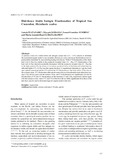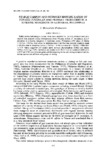Effect of diet isotopic ratios on the \(\mathsf{\delta^{13}C}\) and \(\mathsf{\delta^{15}N}\) signatures of scallop-gut contents in a natural setting
| dc.contributor.author | Aya, Frolan | |
| dc.contributor.author | Kudo, Isao | |
| dc.date.accessioned | 2023-08-30T02:33:30Z | |
| dc.date.available | 2023-08-30T02:33:30Z | |
| dc.date.issued | 2023 | |
| dc.identifier.citation | Aya, F., & Kudo, I. (2023). Effect of diet isotopic ratios on the δ13C and δ15N signatures of scallop-gut contents in a natural setting. Plankton and Benthos Research, 18(3), 140-147. https://doi.org/10.3800/pbr.18.140 | en |
| dc.identifier.issn | 1880-8247 | |
| dc.identifier.uri | http://hdl.handle.net/10862/6475 | |
| dc.description.abstract | The relationship between diet isotopic signatures and the extent of the tissue-diet isotope fractionation factors have been shown previously in controlled feeding studies, but this relationship remains poorly resolved for marine invertebrates in a natural setting. Using isotope analysis of gut contents, this study investigated the variability in tissue-diet isotopic fractionation factors (Δδ13C and Δδ15N) between scallop tissues (i.e. muscle and digestive gland) and gut content in the Japanese scallop Mizuhopecten yessoensis (Jay, 1857) and assessed how the growth rate of juvenile scallops and gut content quality (as carbon to nitrogen (C/N) molar ratios) would affect the values of tissue-diet isotopic fractionation. Tissue-diet isotopic fractionation factors (Δδ13C and δ15N) varied according to tissue, which averaged 1.7‰ and −0.1‰ for N in muscle and digestive gland, and 3.4‰ and 1.2‰ for C in muscle and digestive gland, respectively. Muscle-gut δ15N isotopic factors negatively correlated with growth rate, suggesting that the juvenile δ15N signatures were strongly dependent on food quantity. The influence of diet quality on δ15N was also evident, where δ15N decreased as C/N molar ratios in gut contents increased. The wide difference in Δδ13C and δ15N from accepted standard values may be, in part, a consequence of using gut contents as a dietary proxy. Results of this study have implications for diet reconstruction studies of this scallop species reared under field conditions. | en |
| dc.language.iso | en | en |
| dc.publisher | The Plankton Society of Japan | en |
| dc.relation.uri | https://www.jstage.jst.go.jp/article/pbr/18/3/18_B180303/_pdf/-char/en | |
| dc.subject | scallops | en |
| dc.subject | diet quality | en |
| dc.title | Effect of diet isotopic ratios on the \(\mathsf{\delta^{13}C}\) and \(\mathsf{\delta^{15}N}\) signatures of scallop-gut contents in a natural setting | en |
| dc.title.alternative | Effect of diet isotopic ratios on the δ13C and δ15N signatures of scallop-gut contents in a natural setting | en |
| dc.type | Article | en |
| dc.identifier.doi | 10.3800/pbr.18.140 | |
| dc.citation.volume | 18 | en |
| dc.citation.issue | 3 | en |
| dc.citation.spage | 140 | en |
| dc.citation.epage | 147 | en |
| dc.citation.journalTitle | Plankton and Benthos Research | en |
| dc.subject.asfa | growth | en |
| dc.subject.asfa | nitrogen isotopes | en |
| dc.subject.asfa | scallop culture | en |
| dc.identifier.essn | 1882-627X | |
| dc.subject.scientificName | Mizuhopecten yessoensis | en |
| local.subject | growth | en |
| local.subject | diet composition | en |
| local.subject | Mizuhopecten yessoensis | en |
| local.subject | stable carbon and nitrogen isotopes | en |
| local.subject | tissue-diet isotopic fractionation | en |
| local.subject | Japanese scallop | en |
| local.subject | Ezo giant scallop | en |
このアイテムのファイル
| ファイル | サイズ | フォーマット | 閲覧 |
|---|---|---|---|
|
このアイテムに関連するファイルは存在しません。 |
|||
このアイテムは次のコレクションに所属しています
-
Journal Articles [1256]
These papers were contributed by Department staff to various national and international journals.




